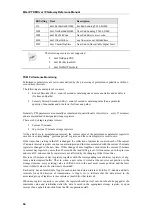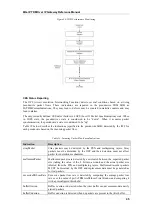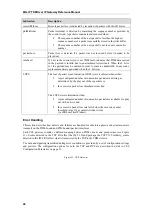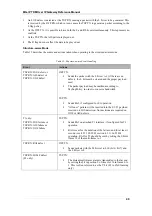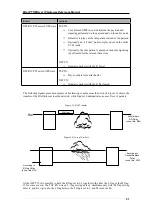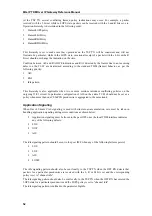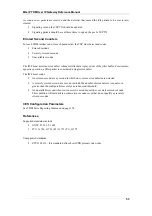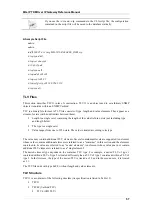
MG-IP TDM Over IP Gateway Reference Manual
44
Bit Setting Item
Description
512
dsx1RcvFarEndLOMF
Far End Sending TS16 LOMF
1024
dsx1XmtFarEndLOMF Near End Sending TS16 LOMF
2048
dsx1RcvTestCode
Near End detects a test code
4096
dsx1OtherFailure
any line status not defined here
8192 dsx1UnavailSigState
Near
End in Unavailable Signal State
The following events are not supported:
dsx1NetEquipOOS
dsx1RcvPayloadAIS
dsx1Ds2PerfThreshold
TDM Performance Monitoring
Performance parameters are raw counts derived by the processing of performance primitives within 1-
second time intervals.
The following are examples of counters:
Errored Seconds (ESs) - count of seconds containing one or more anomalies and/or defects
(for lines and paths)
Severely Errored Seconds (SESs) - count of seconds containing more than a particular
quantity of anomalies and/or defects (for lines and paths)
Generally, PM parameters are normally accumulated at quarter-hourly intervals (i.e., every 15 minutes)
and are maintained in designated storage registers.
There are 96 storage registers termed:
Current 15-minute
96 previous 15-minute storage registers
At the end of every accumulation interval, the current value of the performance parameter register is
saved in its corresponding “previous period” register, and the current register is reset to zero.
If the time of day setting in the NE is changed, the collection of parameter counts in each of the current
15-minute interval registers continues uninterrupted, and the time associated with the current 15-minute
register is changed to the new time. If this change of time lengthens or shortens the current 15-minute
or current day register by more than 10 seconds, the invalid flag is set. All counts saved in the previous
and recent 15-minute or daily registers are not affected by the changing of the time of day.
Previous (15-minute or day) registers, together with the corresponding recent history registers, if any,
form a data structure/buffer. That is, when a new value is stored at the most recent position in the
storage structure, every existing value is shifted down to the next most recent position, and the least
recent (oldest) value in the structure is discarded.
Each entity has an invalid data flag for each current and stored interval, both for 15-minute and daily
intervals for each direction of transmission. A flag is set to indicate that the data stored in the
associated group of registers is incomplete or invalid (for that interval).
When any register capacity is exceeded, the register should not roll over but should be pegged at the
maximum value and reinitialized after the data is saved in the appropriate storage register, or upon
receipt of an explicit instruction from the OS or operations staff.















